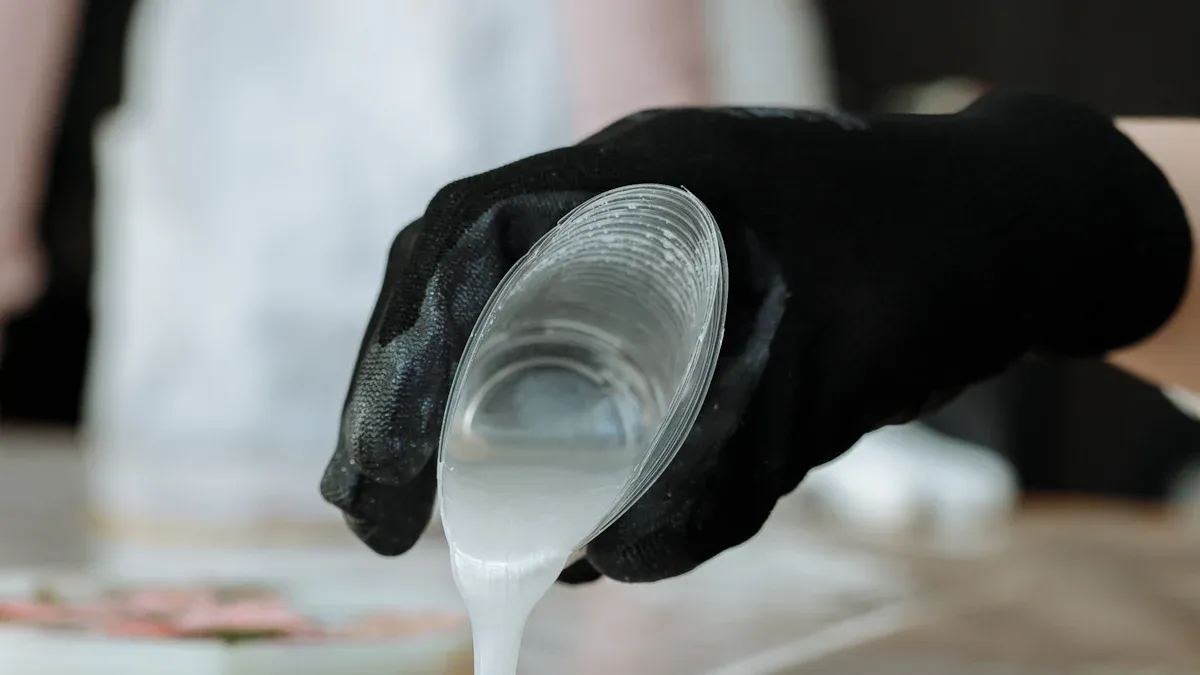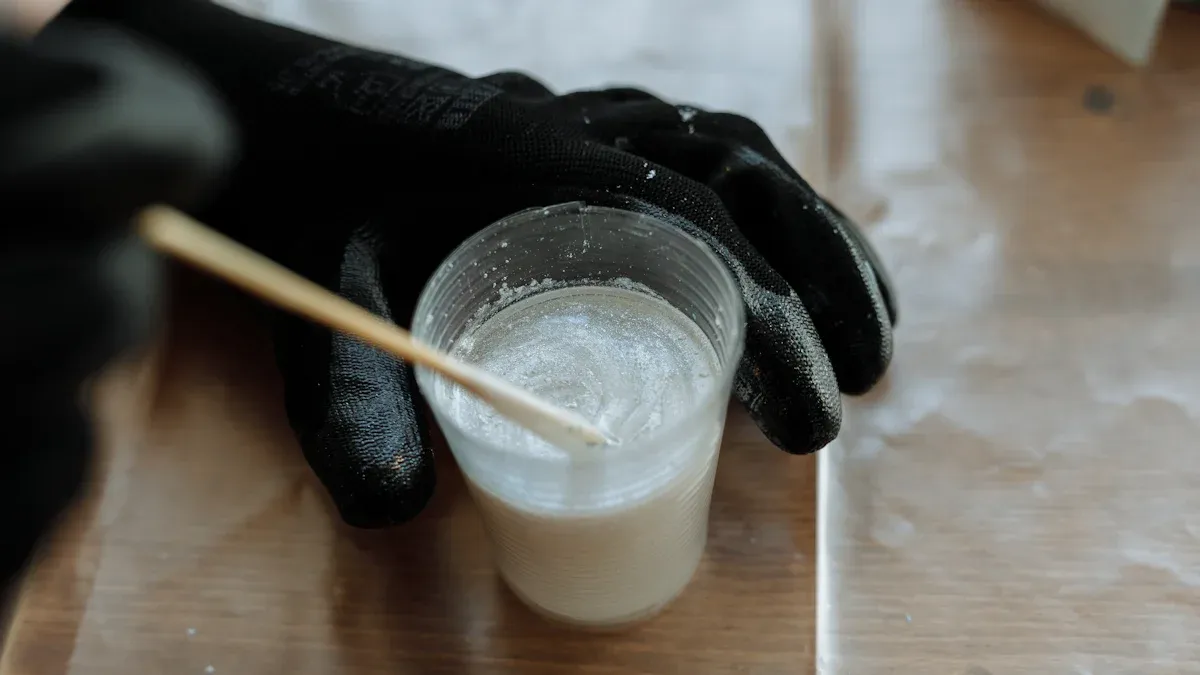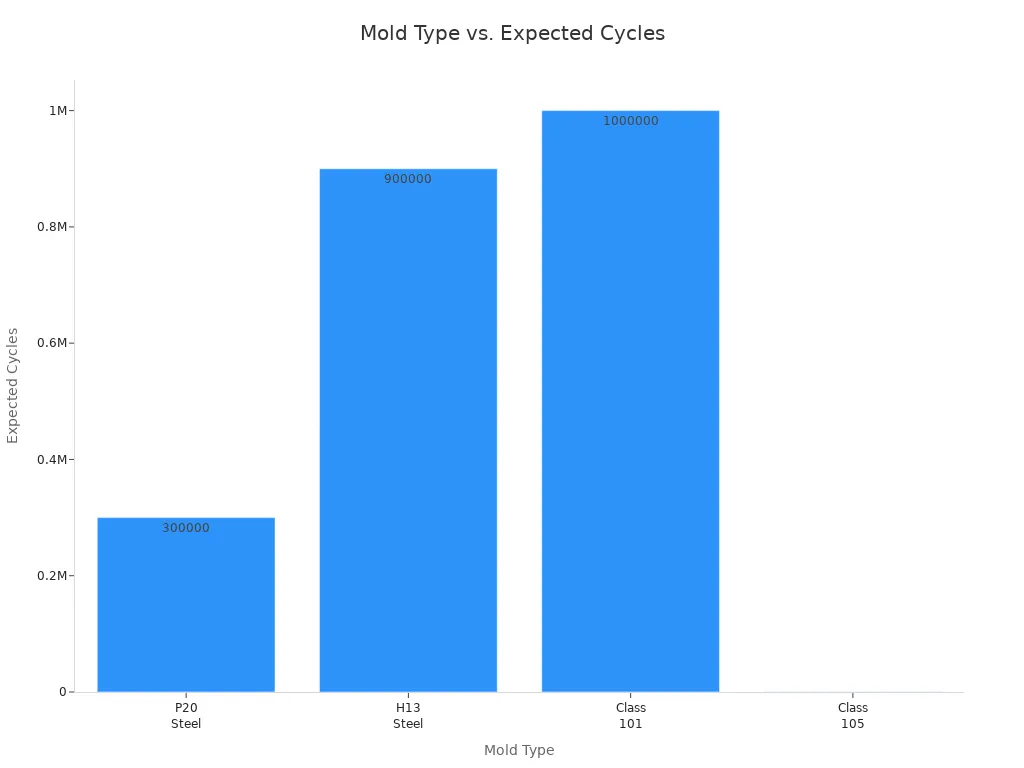Understanding the Key Differences Between Inert and Reactive Molds

The main difference between an inert or reactive mold lies in how they interact with materials. An inert mold does not cause any chemical changes, helping to keep the product pure. In contrast, a reactive mold initiates processes that alter the material. Manufacturers must understand this distinction because the choice between an inert or reactive mold impacts the safety and quality of the final product. Many applications, such as producing food-safe plastics and medical devices, require careful selection of the appropriate mold. Each task demands the right mold type to ensure safe and high-quality results.
Tip: Always choose the mold—whether inert or reactive—that best suits your process and needs for optimal outcomes.
Inert or Reactive Mold Basics

Inert Mold Definition
An inert mold does not react with what goes inside. Manufacturers use inert molds to keep thermosets and thermoplastics the same. These molds stop unwanted chemical reactions. This keeps the final product pure and safe. Inert molds are often made from stainless steel or ceramics. These materials do not rust and do not mix with resins. That is why they are good for food containers and medical devices. They are also used for other products that need to be very clean.
New technology has made inert molds better.
Pre-Deformation Mold Technology helps make complex and exact molds. This raises quality and lowers costs.
Gas Assisted Molding Technology (GAM) uses nitrogen gas. It makes hollow parts with even walls. Products are lighter and stronger. Less material is wasted.
Manifold Injection Molding Technology puts in many materials or colors at once. This gives more design choices and saves time.
These new ideas help make better thermosets and thermoplastics. There is less waste and higher quality.
Reactive Mold Definition
A reactive mold reacts with the materials inside it. This mold starts chemical changes in thermosets or thermoplastics. Reactive molds are made from special steels or alloys. These can handle high heat and strong reactions. They are important when crosslinking or other changes are needed.
Many reactive molds use things like blast furnace slag, fly ash, ladle slag, glass wool, stone wool, volcanic pozzolan, and calcined Finnish clay. These materials react a lot, shown by the R3 test. The R3 test checks heat, setting time, strength, and structure. Ceramic waste powders also have reactive parts. These help make geopolymers. Because of these features, reactive molds are needed for products that must be strong or last long.
New technology for reactive molds includes:
3D metal printing for cooling channels. This cools faster and makes better products.
Conformal cooling channels designed with 3D CFD simulation. This cools better and costs less.
Advanced CAE simulation software, like Moldex3D R15.0, finds problems and helps with hard molding jobs.
New molding ways like gas-assisted injection, water-assisted injection, microcellular foam injection, and chemical foaming. These help control the process and make products more even.
Cloud computing and big data help make things faster and support Industry 4.0.
These new tools help make better thermosets and thermoplastics. The products work better and last longer.
Material | Evidence of Reactivity | Supporting Test Methods and Observations |
|---|---|---|
Blast furnace slag | Classified as reactive (high heat release) | R3 test measuring heat release and bound water; improved setting time, compressive strength, electrical resistivity, denser microstructure |
Fly ash | Classified as reactive (high heat release) | Same as above |
Ladle slag | Classified as reactive (high heat release) | Same as above |
Glass wool | Classified as reactive (high heat release) | Same as above |
Stone wool | Classified as reactive (high heat release) | Same as above |
Volcanic pozzolan Iceland | Classified as reactive (high heat release) | Same as above |
Calcined Finnish clay | Classified as reactive (high heat release) | Same as above |
Note: Ceramic waste powders with lots of amorphous phase also act as reactive materials in molds. They help make geopolymers.
Key Properties
Inert and reactive molds have different properties. These affect how they work with thermosets and thermoplastics. Inert molds keep resins stable and unchanged. This is important for products that must stay pure. Reactive molds help start chemical reactions. These reactions, like crosslinking, change the structure of resins. This can make materials stronger, tougher, or better against heat and chemicals.
Key properties of inert molds:
Do not react with thermoset or thermoplastic polymers.
Keep the original properties of resins.
Help make pure products without contamination.
Key properties of reactive molds:
Cause chemical changes in thermosets and thermoplastics.
Help make products with better material properties.
Often need special care and advanced technology to control reactions.
Manufacturers must pick inert or reactive molds based on the resin, the needed properties, and the final use. The right choice makes sure thermosets and thermoplastics work as they should.
How Inert or Reactive Mold Works
Inert Mold Mechanism
Inert molds are important in compression molding for thermosets and thermoplastics. These molds make a safe place for resins. They stop unwanted changes from happening. Manufacturers use inert gases like nitrogen, argon, or helium. These gases do not react with thermosets or thermoplastics. This keeps the resins clean and safe.
Inert gases fill the mold during compression molding.
These gases push out oxygen and water. Oxygen and water can cause bad reactions with thermosets and thermoplastics.
The safe space stops oxidation and hydrolysis. These problems can hurt resins.
Inert gases make a shield during molding. This keeps thermosets and thermoplastics the same.
This way lowers the chance of contamination. It helps keep the final product good.
Many industries use this process. Food packaging and medicine companies use it to keep products safe.
Tip: Using inert molds in compression molding keeps thermosets and thermoplastics steady. This is needed for very pure products.
Reactive Mold Mechanism
Reactive molds work in a different way for thermosets and thermoplastics. These molds start chemical reactions. The reactions change the structure of resins. Special metals or ceramics are used. They react with thermosets or thermoplastics during molding. This can make the product stronger or better against heat.
Aspect | Description |
|---|---|
Metals like Hafnium in molten alloys react with ceramic molds during compression molding. | |
Chemical Reaction | New compounds form where the mold and material meet. This changes thermosets and thermoplastics. |
Interface Behavior | These new compounds stick to the surface. They can move into the melted material and change molding. |
Effects on Molding | The reaction can change how well the material fills the mold. It can make the surface better or worse. |
Nucleation Sites | The new compounds help start carbides in thermosets and thermoplastics. |
Influence on Alloy | The reaction changes the mix of elements in the product. This affects quality. |
Experimental Validation | Tests show that taking away reactive elements stops these reactions. This proves their role. |
Process Considerations | Controlling reactive elements and the mold surface is important for good results. |
Context | This process is used to make strong parts. Turbine blades from thermosets and thermoplastics are made this way. |
Reactive molds in compression molding help make new features in thermosets and thermoplastics. Manufacturers must watch the process closely to get the best results from the resins.
Applications in Manufacturing

Food-Grade Plastic Injection Molding
Food-grade plastic injection molding makes safe containers and packaging. Manufacturers pick food-grade material options that follow strict rules. These choices stop contamination and keep products safe for people. Inert molds are important here. They do not react with plastic or additives, so the product stays pure. Many companies use molds with sensors to check temperature and pressure. This helps keep tight tolerances and high quality. Additive manufacturing helps make better mold designs and cooling. This makes food-grade plastic injection molding more efficient.
Note: Inert environments and inert gases like nitrogen keep the process clean and stop bad reactions.
Medical and High-Purity Uses
Medical and high-purity uses need very clean and safe products. Syringes, surgical tools, and drug devices use food-grade material options. These do not leak chemicals or react with drugs. Inert molds made from stainless steel or ceramics help by giving a stable process. Sensors at the mold-melt interface give real-time data. This makes sure every step meets strict rules. Medical-grade fluoropolymers and coatings also need inert environments to stay clean. Advanced process control helps keep products pure and the same every time.
Industrial Examples
Industrial uses include many products, like car parts and electronics. The mold type and material change the process and product quality. P20 steel molds are good for medium runs. H13 steel molds work for high heat and last longer. The table below shows common processes and what they make:
Manufacturing Process | Description | Typical Applications |
|---|---|---|
Makes lots of metal parts using steel molds and high-pressure molten metal | Car parts, hardware, toys | |
Injection Molding | Makes plastic parts by injecting melted plastic into molds | Plastic cases, containers, electronics |
Compression Molding | Shapes thermosetting plastics and rubber with heat and pressure | Car bumpers, electrical housings |
Rotational Molding | Makes big, hollow items by spinning heated molds | Storage tanks, toys, sports equipment |
Manufacturers know that the process and mold choice affect how long products last, cost, and how well things work. The chart below shows mold types and how many cycles they last:

Car, electronics, packaging, and building products all need the right process and food-grade material options. Inert environments and gases help keep quality high in these uses.
Comparison and Selection
Material Compatibility
Material compatibility is very important in manufacturing. Engineers must pick the right mold for the material. Thermosets and thermoplastics need different things. Thermosets change when they get hot. Thermoplastics can melt and harden again and again. The mold must help with these changes.
Thermosets need molds that handle high heat and pressure. Compression molding works well for thermosets. It shapes them before they set. Thermoplastics need molds that cool fast and let parts out quickly. Compression molding for thermoplastics is about speed and doing the same thing every time.
Material Type | Mold Requirement | Typical Process | Key Consideration |
|---|---|---|---|
Thermosets | High heat resistance | Compression molding process | Chemical stability |
Thermoplastics | Fast cooling, easy release | Compression molding process | Dimensional accuracy |
The right mold keeps the material’s properties the same. This helps the product stay safe and good quality. Picking the wrong mold can make products not work well or even break.
Process Outcomes
How well the mold works with thermosets and thermoplastics affects the results. Compression molding shapes both materials, but the results are not always the same. Thermosets get stronger and resist heat better. Thermoplastics become bendy and easy to shape.
Engineers check many things to see how the process went:
Surface finish: A good mold makes thermosets and thermoplastics smooth.
Dimensional accuracy: Compression molding must keep parts the right size.
Cycle time: Thermoplastics can be made faster than thermosets.
Material waste: The right process uses less material and saves money.
Product consistency: Good molds help thermosets and thermoplastics turn out the same every time.
Tip: Always test the mold with thermosets and thermoplastics before making a lot. This helps find problems early.
How the product works depends on the process. If the mold does not fit the material, the product may not work well. For example, a bad fit can make thermosets crack or break. Thermoplastics might bend or shrink if the process is wrong. Compression molding must match the material for the best results.
Choosing the Right Mold
Picking the right mold means thinking about thermosets, thermoplastics, and the process. Engineers need to know what the product will do, how it should perform, and what the compression molding process needs.
Here is a simple checklist for picking a mold:
Identify the material: Is it thermosets or thermoplastics?
Check process needs: Does compression molding need high heat or fast cycles?
Review performance goals: Does the product need to be strong, bendy, or resist heat?
Test for compatibility: Try the mold with thermosets and thermoplastics if you can.
Monitor process outcomes: Watch for changes in how the product works or feels.
A good mold choice helps products work better everywhere. The right mold helps compression molding and lets thermosets and thermoplastics do their best. Engineers should always check the process and test to get the best results.
Note: The right mold can make products work better, cost less, and be safer.
Pros and Cons
Inert Mold Advantages
Inert molds help keep the process safe and steady. They do not react with materials, so products stay pure. Many companies use inert molds for food containers and medical tools. These molds use gases like nitrogen or argon to keep things clean. This stops bad reactions and helps products work better. Using inert molds means there are fewer mistakes and less waste. It is also easier to control the process and follow strict rules for clean products.
Inert molds make the process steady and safe. They are a good pick for jobs where product quality is very important.
Reactive Mold Advantages
Reactive molds give many benefits to the process and products. Engineers can use special cooling channels that fit the mold shape. This cools parts evenly and stops hot spots. The process goes faster, and parts work better with less bending. Lattice shapes inside the mold make it lighter and save material. Engineers can add heaters and sensors for better control. A new self-sealing way cures the edge of the part, which saves time and cuts waste. Reactive molds let people use thermoset materials in new ways, like vacuum forming with special reactions. This makes parts stronger and better against heat and chemicals. The process with reactive molds helps advanced industries get top results.
Additive manufacturing makes complex molds and better cooling.
The process is faster and makes more parts.
Thermoset parts work better in tough places.
Limitations
Both inert and reactive molds have limits that affect how they work. Inert molds cost more at first and need special gases and trained workers. The table below lists some main problems:
Limitation/Drawback | Explanation |
|---|---|
High Initial and Operational Costs | Equipment and gas costs make the process more expensive. |
Complexity in Maintenance | The process needs trained workers and lots of checks. |
Potential Hazards | Gas leaks or mistakes can hurt workers during the process. |
Environmental and Space Limits | Some places cannot use inert molds because of space or process issues. |
Regulatory Challenges | The process must follow strict rules, which takes more time and money. |
Impact on Product Quality | Mistakes can cause contamination or raise quality control costs. |
Reactive molds also have problems in the process. They need tight seals because the mix stays runny for a long time. The process must handle high heat and strong chemicals. Water and air can ruin the process, so special vacuums are needed. The process can also have trouble with heat from reactions and may not work for every job.
The process for reactive molds is hard and needs careful watching.
High heat and strong chemicals can hurt the mold and lower how well it works.
Some reactions cannot last long, so not everything can be made.
Inert molds do not change materials during use. Reactive molds cause chemical changes that make things stronger or last longer. Picking the right mold is very important for food and medical products. Here are some tips to keep the process safe:
Choose plastics like PE, PP, PS, or PVC for safety and strength.
See if you need the material to resist water or chemicals.
Use thermoplastics if you want to melt and shape them again.
Pick the right material for what you are making, like HDPE for bottles.
Make sure the material can be cleaned with heat or chemicals.
Always follow ISO 13485 and FDA rules.
Write down every step you take in the process.
Talk to your suppliers early to get help.
Pick a process that fits the size and shape you need.
Try out the process before making lots of parts.
For important jobs, ask experts and do tests to make sure everything is safe and good quality.
FAQ
What is the main difference between inert and reactive molds?
Inert molds do not make chemical changes happen. Reactive molds start chemical reactions that change the material. This difference changes how pure and strong the product is.
Why do food and medical products often use inert molds?
Food and medical products must be very pure. Inert molds stop bad reactions from happening. This keeps the products safe for people.
Can reactive molds improve product strength?
Yes. Reactive molds help make products stronger or better with heat. They do this by starting chemical changes during molding.
Are inert molds more expensive than reactive molds?
Inert molds usually cost more at the start. They need special materials and gases. But they help lower waste and make products safer.
How do manufacturers choose the right mold type?
Manufacturers think about the material, how the product will be used, and safety. They test molds with their materials. They also follow industry rules and standards.
See Also
How To Properly Inspect And Test Die Casting Molds
Key Elements That Affect The Price Of Die Cast Molds
An Easy Explanation Of How Semi-Solid Casting Functions
The Advantages Of Using CAE Analysis In Die Casting
Exploring Cavity Molds And Their Role In Manufacturing
About Hunan Puka
Established in 2016 and based in Hunan, China, with a liaison point in Berlin, we are a Tier 2 supplier for the automobile industry. We specialize in the production of customized aluminum die-casting parts designed for machines with a closing force ranging from 280 to 1250 tons, with subsequent manufacturing process CNC machining and surface treatment. Our commitment to quality is reflected in our accredited quality management system, certified by ISO9001:2015 and IATF16949:2016 standards.


